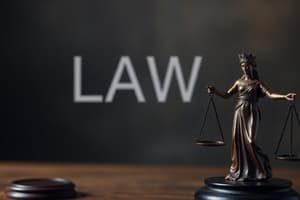Podcast
Questions and Answers
What is the short title of RA 9266?
What is the short title of RA 9266?
- Building Code of the Philippines
- Architectural Regulation Act
- Architecture Act of 2004 (correct)
- Architecture and Design Law
What is the definition of architecture?
What is the definition of architecture?
Art, science or profession of planning and constructing buildings in their totality taking into account their environment in accordance with the principles of utility, strength, and beauty.
The Architect of Record has civil liability for the plans they signed and sealed.
The Architect of Record has civil liability for the plans they signed and sealed.
True (A)
Which of the following is NOT a source of law?
Which of the following is NOT a source of law?
Match the following terms with their definitions:
Match the following terms with their definitions:
The totality of the norms of good and right conduct is known as ______.
The totality of the norms of good and right conduct is known as ______.
What does CPD stand for?
What does CPD stand for?
An architect must be a member of the faculty of any school where BS Arch is taught to qualify for the Professional Regulatory Board.
An architect must be a member of the faculty of any school where BS Arch is taught to qualify for the Professional Regulatory Board.
Who is the current chairman of the Professional Regulatory Board of Architecture?
Who is the current chairman of the Professional Regulatory Board of Architecture?
The organization that integrates and accredits professional architects is known as ______.
The organization that integrates and accredits professional architects is known as ______.
Flashcards are hidden until you start studying
Study Notes
Kinds of Laws
- Divine Law: Based on religion and faith.
- Natural Law: Inspired by a sense of justice, fairness, and righteousness, not through revelation.
- Moral Law: Collective norms about right and wrong conduct within a community.
- State Laws: Promulgated and enforced by the government.
- Physical Law: Uniformities and sequences observed in nature’s actions.
Sources of Law
- The Constitution: The 1987 Constitution of the Philippines.
- Administrative Orders: Orders, regulations, and rulings from the executive branch.
- Judicial Decisions: Also known as jurisprudence, these are rulings from the courts.
- Legislation: Laws passed by the legislative branch.
- Customs: Traditions and practices with legal force.
- Other Sources: Including international treaties and agreements.
Architecture Act of 2004 (RA 9266)
- Short Title: Architecture Act of 2004.
- Purpose: Comprehensive regulation for the registration, licensing, and practice of architecture in the Philippines.
- Repeals: Repeals RA 545, the previous law regulating architecture.
Architecture Definitions
- Architecture: The art, science, and profession of planning and constructing buildings, considering their environment, with principles of utility, strength, and beauty.
- Architect: A licensed, registered, and qualified professional with a Certificate of Registration and professional identification card issued by the PRBOA and PRC.
- Architect of Record: Responsible for the overall design, including Civil Liability for the plans signed and sealed.
- Architect-in-Charge of Construction: Responsible for supervising the building's construction.
General Practice of Architecture
- Scope: Planning, designing, structural conceptualization, specifying, supervising, and administering the construction, enlargement, or alteration of buildings.
- Coordination: Orderly process to produce a complete building.
- Structural Conceptualization: Conceiving, choosing, and developing structural elements with considerations for safety, cost, functionality, and aesthetics.
Architecture Entities
- Architectural Firm: A registered proprietorship, partnership, or corporation.
- Professional Regulatory Board of Architecture (PRBOA): Responsible for regulating the profession.
- Professional Regulation Commission (PRC): Governing body responsible for professional licensing.
- Integrated and Accredited Professional Organization of Architects (IAPOA): Example: UAP (United Architects of the Philippines, Inc.)
- Continuing Professional Development (CPD): Professional development requirements.
- Department of Trade and Industry (DTI): Government agency responsible for trade and industry.
- Securities and Exchange Commission (SEC): Governing body for corporations and securities.
- Department of Labor and Employment (DOLE): Government agency responsible for labor and employment.
- Registered and Licensed Architect (RLA): Architect with a license and registration.
- Code of Ethical Conduct: Norms and principles for ethical practice in architecture.
Contract Documents
- Components: General Conditions, Special Provisions, Drawings, Specifications, and Other Bid Documents.
Other Key Concepts
- Copyright: Legal protection for original works of authorship.
- Diversified Architectural Experience: Two years of experience required before taking licensing exams.
- Filipino Counterpart: A local architect must collaborate with a foreign architect on projects in the Philippines.
- Sole Proprietorship: An individual architect practicing and providing architectural services, registered with DTI, PRBOA, and PRC.
PRBOA Composition and Qualifications
- Composition: One chairman and two members appointed by the President.
- Appointment Process: PRC and IAPOA submit a list of nominees, the President appoints from a list of three recommendees.
- Current Members: Chairman: Robert S. Sac; Members: Robert M. Mirafuente, Fidel Jose R. Siapno.
- Qualifications: Filipino citizen, BS Arch degree, Certificate of Registration and Professional Identification Card, 10 years of active practice, not a faculty member in any BS Arch school.
- Former Teachers: Must have officially resigned from teaching for at least five years prior to nomination.
- Other Requirements: No criminal convictions, not an elected officer of IAPOA or other organizations of architects.
Moral Turpitude
- Definition: Behavior considered contrary to community standards of justice, honesty, or good morals.
Studying That Suits You
Use AI to generate personalized quizzes and flashcards to suit your learning preferences.




